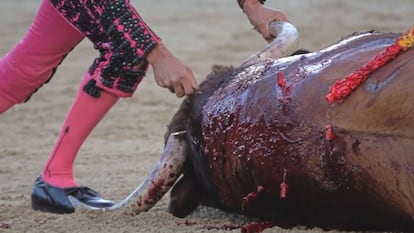Blood, fear and death: a bullfight from the bull’s point of view
Spain’s animal-rights party PACMA presents documentary focusing on what the animals go through in the ring

The scenes are shot from the bull’s perspective. The camera focuses on the animal, and it is very explicit: there are close-ups of blood, spasms, vomit, drool, urine and feces brought on by the pain and the fear. But the thing that strikes viewers the most is the helpless look in the bovine’s eyes.
The editing and the musical score (selected for maximum effect) put the finishing touches to a disturbing portrayal of this most Spanish tradition.
It was evident to me that there was a story there waiting to be told
Jaime Alekos, video journalist
Spanish animal-rights party PACMA has presented its latest documentary, Tauromaquia, which begins with a quote by Juan Belmonte, considered the father of modern bullfighting: “When, during its walks in the field, the bull runs into a presumed enemy, it merely turns around and retreats to its querencia [a spot where it feels safe].”
During the next 30 minutes, the film shows scenes that were all recorded at bullfights, using literary quotes to depict “the death of the bull as never seen before,” according to PACMA.
There are no testimonies, no opinions by either animal welfare activists or bullfighting experts. There are no hidden cameras. Nothing that one cannot see on any given day at an ordinary bullring.
Aesthetically, the film follows the structure of a real bullfight, with its various stages – tercio de varas, tercio de banderillas... Yet the end result bears little resemblance to most televised coverage of a corrida.

“The images are not those you would normally see at a televised event, yet they happen, it all depends on where you point the camera,” explains the film director, video journalist Jaime Alekos, whose goal was to “portray the bull as a sentient being.”
Alekos, 32, had already made a video for PACMA last year showing a becerrada – in which an animal too young for the regular ring is used – in Valmojado (Toledo). In it, local residents are seen “fighting” a calf so young that it cannot coordinate its legs properly yet, and which falls to its knees when it tries to run. That documentary triggered a wave of indignation against animal abuse, including an editorial in EL PAÍS.
In this latest video, the bull does not come across as a life-threatening, half-ton beast, but as “a creature who does not understand what is happening, who feels trapped from the moment he enters the arena, and who only wants to get away from the pain and the fear.”
The images are not those you normally see at a bullfight on television
Jaime Alekos, video journalist
Alekos first went to a bullfight in 2014 – he had been to one as a child, but cannot remember a thing – to record a planned action by activists who were going to jump into the arena. In the end they did not jump, but Alekos kept recording anyway “out of curiosity, since I was already there.”
“When I saw the images at home, I realized that I had instinctively focused on the bull, all my frames showed the animal... And there were many things there that I had never seen before. All my visual references of a corrida were artistic, anthropological, folkloric,” says the filmmaker. “It was evident to me that there was a story there waiting to be told.”
He spent the next three years attending fights and reading material where he sourced his quotes by famous toreros. The video will be available on Wednesday on the website Misión Abolición. Alekos said he is curious to know what fans of bullfighting will have to say about it.
“The thing is, what takes place inside a ring can be viewed from two perspectives,” says Alberto de Jesús, director of Bousalcarrer.com and a former banderillero (the person who assists the main torero by plunging the banderillas into the bull’s back). “Once I took a friend to see José Tomás fight: I walked out in ecstasy, he walked out in horror. We saw different things: I saw the art, and he saw the blood.”
The documentary has very aesthetic parts... but something else is taking place at the same time
According to this expert, fans are the last people who want to see the bull suffer, and this only happens when the animal is tame. “A toro bravo does not suffer, he wants to fight.”
“The documentary seems fine to me, I mean fine for a PACMA documentary,” says the EL PAÍS bullfighting critic, Antonio Lorca. “It shows one aspect of the truth about the fiesta – although it has been twisted, in my opinion. It is the bloodiest, most disagreeable, less interesting part for everyone, fans and non-fans alike.”
“The fiesta is not based on mistreatment or torture, and fans do not enjoy watching animals suffer,” adds Lorca. “Violence and blood are part of the fiesta, but it goes beyond that. Just like chickens live to lay eggs and make a good broth, the fighting bull exists to be fought at the ring. As a fan I don’t consider myself a torturer; rather, I feel like a player in a society where bullfighting is a way of perceiving beauty.”
“Tauromaquia is not an attack against the bullfighting world,” explains Alekos. “I never once deny that it can be an art form. In fact, the documentary has very aesthetic parts... but something else is taking place at the same time: the undeniable physical and emotional suffering of the bull.”
And therein lies the key to the film. “The debate is not whether bullfighting is an art form or not,” says Alekos. The debate is whether it makes sense, in the 21st century, for it to be legal to have shows where the suffering and death of an animal is a necessary requirement.”
English version by Susana Urra.
Tu suscripción se está usando en otro dispositivo
¿Quieres añadir otro usuario a tu suscripción?
Si continúas leyendo en este dispositivo, no se podrá leer en el otro.
FlechaTu suscripción se está usando en otro dispositivo y solo puedes acceder a EL PAÍS desde un dispositivo a la vez.
Si quieres compartir tu cuenta, cambia tu suscripción a la modalidad Premium, así podrás añadir otro usuario. Cada uno accederá con su propia cuenta de email, lo que os permitirá personalizar vuestra experiencia en EL PAÍS.
¿Tienes una suscripción de empresa? Accede aquí para contratar más cuentas.
En el caso de no saber quién está usando tu cuenta, te recomendamos cambiar tu contraseña aquí.
Si decides continuar compartiendo tu cuenta, este mensaje se mostrará en tu dispositivo y en el de la otra persona que está usando tu cuenta de forma indefinida, afectando a tu experiencia de lectura. Puedes consultar aquí los términos y condiciones de la suscripción digital.
More information
Archived In
Últimas noticias
Most viewed
- Reinhard Genzel, Nobel laureate in physics: ‘One-minute videos will never give you the truth’
- Oona Chaplin: ‘I told James Cameron that I was living in a treehouse and starting a permaculture project with a friend’
- Pablo Escobar’s hippos: A serious environmental problem, 40 years on
- Charles Dubouloz, mountaineering star, retires at 36 with a farewell tour inspired by Walter Bonatti
- Why we lost the habit of sleeping in two segments and how that changed our sense of time










































